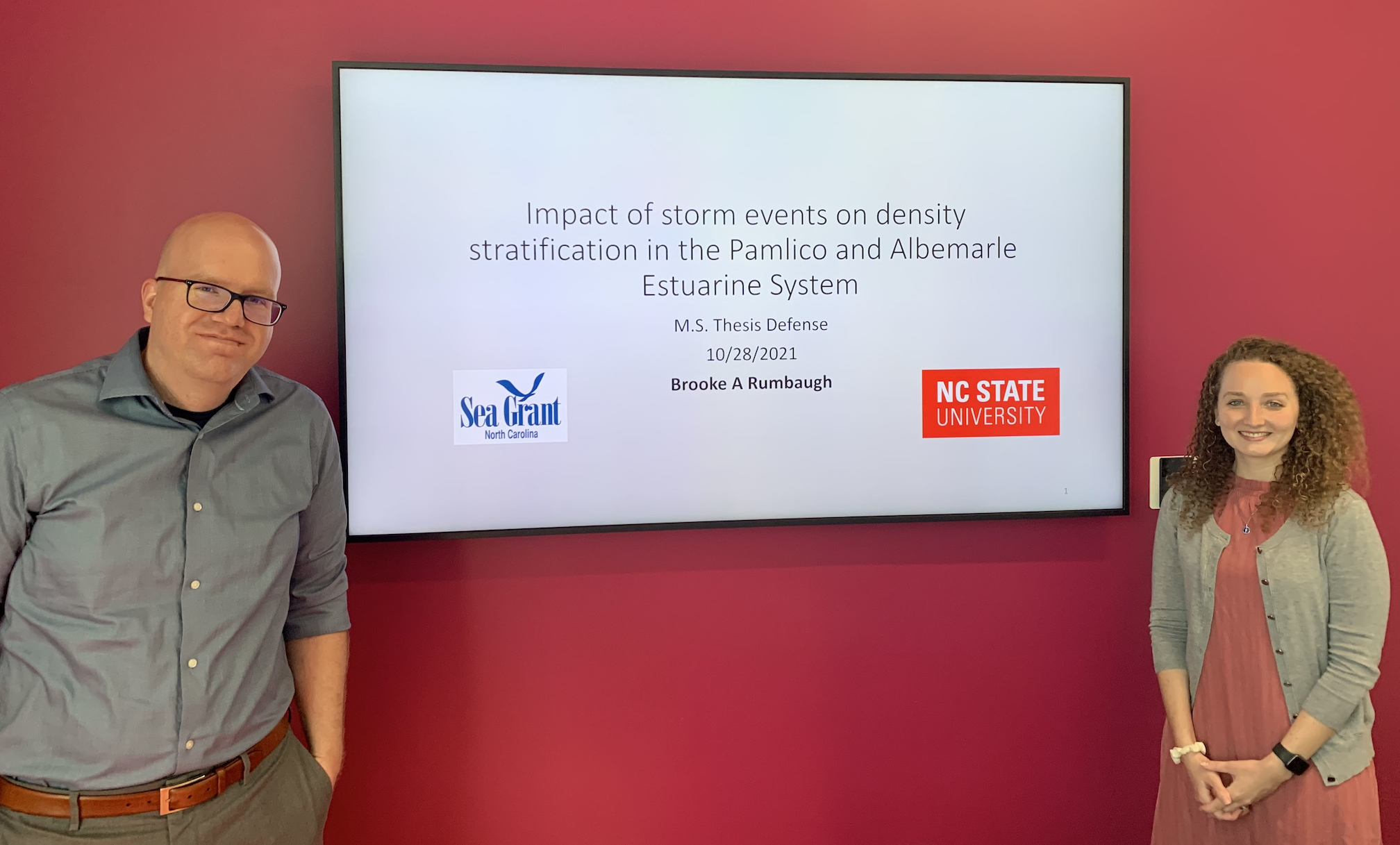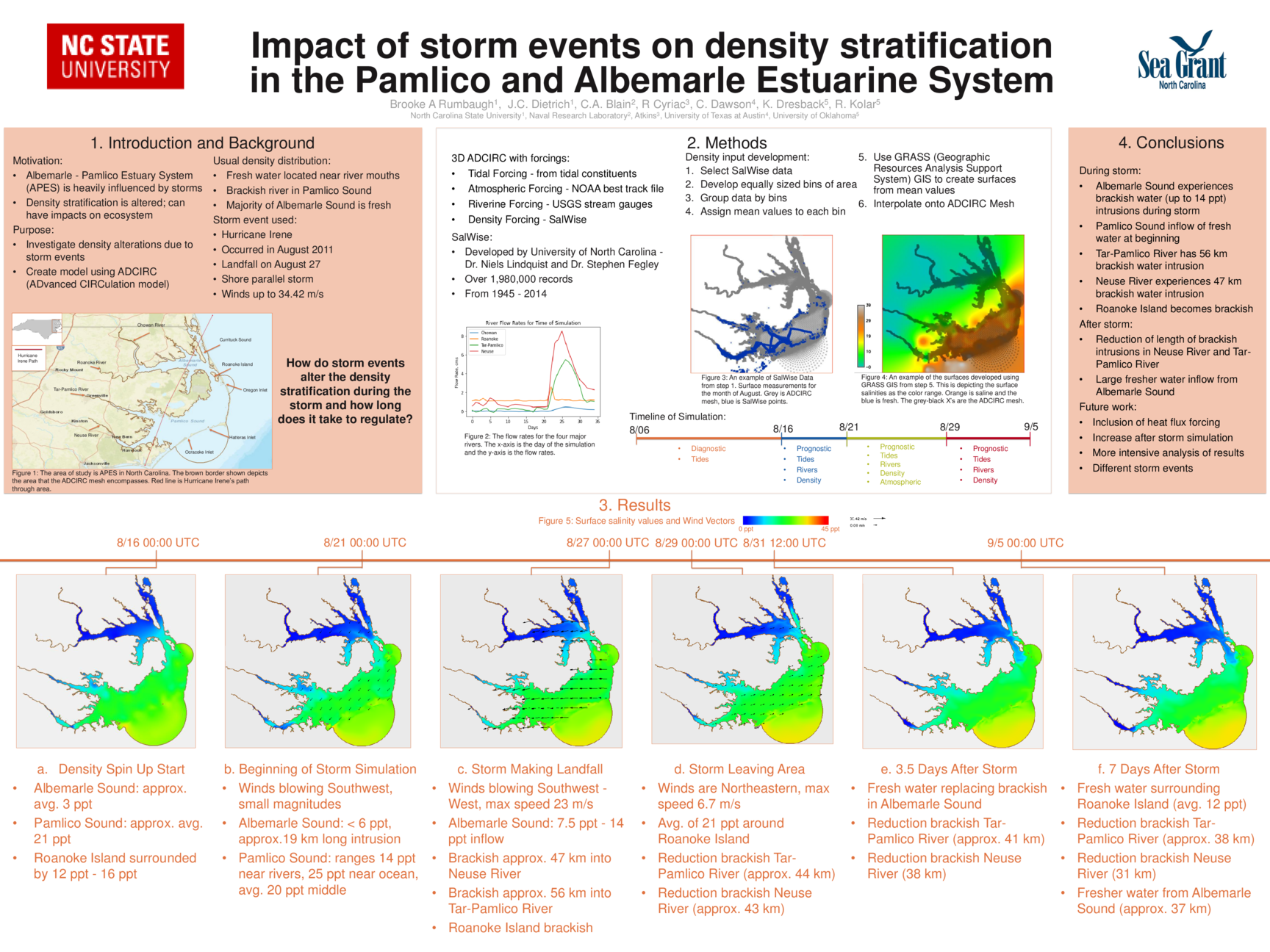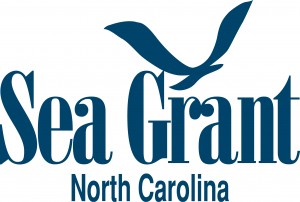Category Archives: NC Sea Grant 2020-2022
Impact of Storm Events on Density Stratification in the Pamlico and Albemarle Estuarine System
 Numerical models can represent the coastal environment and its response to the combined effects of tides, river flows, and winds. It is especially challenging for numerical models to represent the response of estuaries to storms, due to the complex interactions of fresh and saline waters, and thus relatively few studies have used models to represent both storm- and density-driven circulation in estuaries. These few studies have shown that salinities and temperatures of estuaries can change significantly during storms and may require weeks to recover, depending on the amount of freshwater discharge. However, these studies have been limited in number and geographic coverage, relied on coupling to other models for baroclinic inputs, did not have the estuarine mixing and stratification as a focus, or were missing physics. Much is still uncertain about how estuarine circulation evolves during a storm event. How quickly do the horizontal salinities respond to the storm? How does the salinity transport vary through an estuary? How do freshwater discharges due to rainfall affect the mixing? Another uncertainty is the salinity response after the storm. How quickly does a system recover? Do the freshwater discharges interrupt the recovery? In this thesis, it is hypothesized that, for a large and shallow estuarine system with minimal connections to the open ocean, the storm forcing will cause large brackish and freshwater intrusions and recoveries that vary through the system.
Numerical models can represent the coastal environment and its response to the combined effects of tides, river flows, and winds. It is especially challenging for numerical models to represent the response of estuaries to storms, due to the complex interactions of fresh and saline waters, and thus relatively few studies have used models to represent both storm- and density-driven circulation in estuaries. These few studies have shown that salinities and temperatures of estuaries can change significantly during storms and may require weeks to recover, depending on the amount of freshwater discharge. However, these studies have been limited in number and geographic coverage, relied on coupling to other models for baroclinic inputs, did not have the estuarine mixing and stratification as a focus, or were missing physics. Much is still uncertain about how estuarine circulation evolves during a storm event. How quickly do the horizontal salinities respond to the storm? How does the salinity transport vary through an estuary? How do freshwater discharges due to rainfall affect the mixing? Another uncertainty is the salinity response after the storm. How quickly does a system recover? Do the freshwater discharges interrupt the recovery? In this thesis, it is hypothesized that, for a large and shallow estuarine system with minimal connections to the open ocean, the storm forcing will cause large brackish and freshwater intrusions and recoveries that vary through the system.
 To investigate this hypothesis, we developed a three-dimensional model of storm- and density-driven circulation in the Albemarle-Pamlico Estuarine System (APES) in North Carolina. Irene (2011) was used as the basis for storm event simulations to examine the evolution of the horizontal salinity distribution. Included in this model were hurricane-strength winds and pressures, tides, river discharges, and density circulation. Using this model, it was determined that during Irene, APES experienced movements of brackish water into the estuaries and saline water into the sounds. These movements were heavily dependent on the winds. After the stormsimulation, the large river discharges produced intrusions of fresher water into major areas of the sound, and after two weeks, the system was not fully regulated.
To investigate this hypothesis, we developed a three-dimensional model of storm- and density-driven circulation in the Albemarle-Pamlico Estuarine System (APES) in North Carolina. Irene (2011) was used as the basis for storm event simulations to examine the evolution of the horizontal salinity distribution. Included in this model were hurricane-strength winds and pressures, tides, river discharges, and density circulation. Using this model, it was determined that during Irene, APES experienced movements of brackish water into the estuaries and saline water into the sounds. These movements were heavily dependent on the winds. After the stormsimulation, the large river discharges produced intrusions of fresher water into major areas of the sound, and after two weeks, the system was not fully regulated.
From this research, we have developed a better understanding of the horizontal salinity distribution of APES as well as how the system reacts to a single storm event. This research allows for future studies to consider different types of storms along with refinement of the river forcings, to understand better the full range of estuarine responses.
Brooke Rumbaugh defends MS Thesis

Casey and Brooke celebrate after a successful thesis defense.
Thesis Defense: Brooke Rumbaugh
Poster: ASBPA Coastal Conference 2021
Virtual Conference: EWC Symposium 2021
Improving Predictions of Estuarine Flooding and Circulation during Storms
The research plan will have two components. First, the existing modeling system will be enhanced for the NC estuaries, and numerical experiments will explore the sensitivities of estuarine flooding to the main drivers during storms. By varying systematically the atmospheric forcing, bottom friction, incoming river flows, and other parameters, we will improve our understanding of how storm surge is developed in these regions. Second, the modeling system will be extended to consider density-driven circulation and salinity transport, by leveraging earlier work for estuarine circulation in the northern Gulf. It is known that horizontal salinity transport during storms can threaten marine life and vegetation, but there is not currently a modeling system that can predict both transport and overland flooding. This project will combine those processes and explore questions about stratification during storms. While these interactions are important in estuaries along the U.S. Gulf and Atlantic coasts, they are especially important for the NC estuaries and their nearby communities, which have been devastated by storms in recent years.
The project will also have an extensive education component. Via collaboration with the Coastal Studies Institute, we will develop and implement lesson plans for storm surge and coastal flooding. It is expected that this new program will engage with more than 300 students in northeastern NC. The research team is well-positioned to contribute to these outreach activities, thus benefiting coastal communities in NC.
JC Dietrich, RJ McCord. “Improving Predictions of Estuarine Flooding and Circulation during Storms.” National Oceanic and Atmospheric Administration, North Carolina Sea Grant, 2020/02/01 to 2022/01/31, $119,370 (Dietrich: $99,610).
News: CCHT Leads a Core Research Project for NC Sea Grant
NC Sea Grant Announces 2020–2022 Core Research Projects
North Carolina Sea Grant’s core research projects for 2020 to 2022 will apply innovative approaches to coastal issues. Research teams across the state are starting new studies on coastal resilience, climate change, flooding, shellfish and aquaculture, environmental literacy and more.
“Our core research examines real-world needs of our coastal communities and ecosystems,” says Susan White, executive director of North Carolina Sea Grant. “We are pleased to have so many multidisciplinary collaborations that address our program’s strategic focus areas.”



